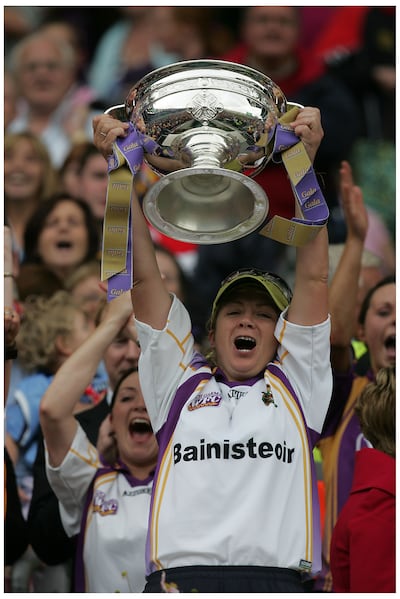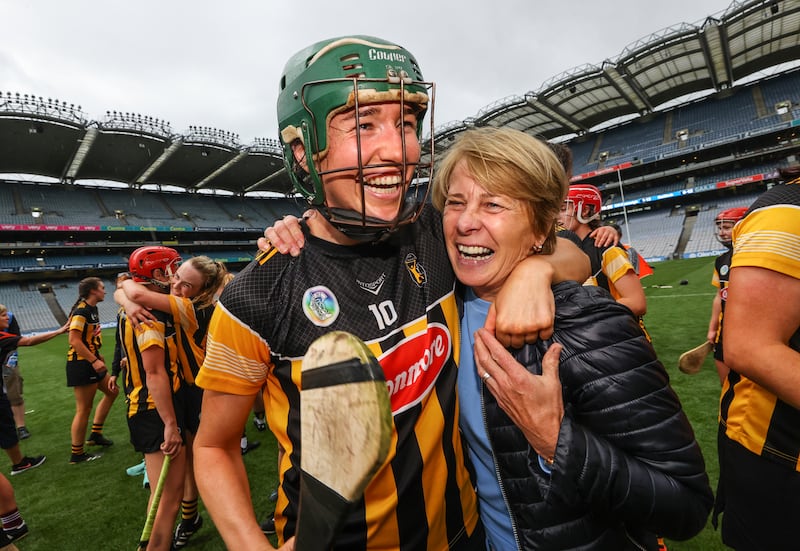When Stellah Sinnott was interviewed for the role of Wexford camogie manager, the other three candidates were men. In her long and illustrious career as a player with Buffer’s Alley and Wexford, she had never been coached by a woman. It wasn’t a point of contention in the game: it was a self-perpetuating state of affairs and the accepted norm. Camogie was a game played by women and mostly managed by men.
Sinnott had been a selector for the previous couple of seasons, and when the manager stood down the players encouraged her to apply for the job.
“At that stage in camogie it could be anybody that would go for a manager’s job,” says Sinnott now, 16 years later.
“Might get it, might not. Whereas now, it’s a lot more professional, the set-ups are a lot more professional.
“Alan Aherne came in with me, as like an assistant manager, and I remember going into the first selection meeting with the county board and saying to Alan, ‘Are we mad?’”
In 2007, her debut season as manager, Wexford won the All-Ireland for the first time in 32 years. But when Sinnott stepped down two years later there wasn’t another woman to take her place, and nobody agonised about that vacuum.
In recruiting JJ Doyle as their new manager, Wexford reverted to the norm. Doyle led them to three All-Irelands in a row, and just as they had chosen wisely with Sinnott, the Wexford county board made an excellent appointment in Doyle too.

No other woman has stepped up since Sinnott, though, and she doesn’t see any potential candidates on the horizon. Why should that be the case? Not just in Wexford, and not just in camogie, but across the ever-expanding territory of women’s Gaelic games? Are women not encouraged to take those roles, or not empowered to do so? Why is the gender balance so skewed?
By the end of this year, every sports organisation is obliged to have 40 per cent female representation on its governing board or face “financial consequences” – a threat repeated in a letter sent to national governing bodies by Minister for Sport Catherine Martin in December.
At that stage, data compiled by Sport Ireland showed that the IRFU, the FAI and the GAA were significantly short of that target, with the FAI leading the Big Three on just 25 per cent. Camogie and women’s football had their houses in order: 11 of camogie’s 17 board members were women, and in Women’s Gaelic Football the number was 10 of 19.
On the administrative side of sport there is an obvious merit in using a quota system to drive gender equality. Applying that principle to team managements, though, wouldn’t necessarily produce more women in leadership roles. Management teams are so large and diverse now that a 40 per cent threshold could be reached by offering any number of less influential positions to women.
Instead, the challenge is to create a different environment and different expectations. Of the top 12 teams in this year’s senior camogie leagues, 10 are managed by men. Why should it be unusual for a woman to be in charge?
If your training sessions are good, and the girls feel they’re getting something out of it, it doesn’t matter whether it’s male or female – it’s all about the session
— Ann Downey
Ann Downey is one of the greatest camogie players of all-time and in 2011 she assumed the role of Kilkenny manager. In hurling or Gaelic football that is a well-trodden path: great player dons the bainisteoir’s bib. That equation, however flawed, doesn’t exist in camogie. Just like Sinnott, Downey’s playing days were characterised by playing for male coaches and managers.
“Going back to my time playing,” says Downey, “it was more a matter of who would take the job.”
So, if finding candidates was difficult, why haven’t more women stepped forward? “I suppose the biggest problem is time, to be quite honest,” Downey says.
“Isn’t it always traditional that – in hurling, football, camogie or women’s football – that the men probably have the free time to go and train teams while the wife will look after everything at home?
“Like, it’s seven days a week. It’s a fierce commitment. And now, women are in top professional full-time jobs too, and to give it the time is a huge commitment.”

Downey had been involved with Kilkenny teams as a selector going back to the early-2000s and it was clear that she had an aptitude for management. As a player she had won 12 All-Irelands, so it wasn’t as if she needed a map to find Croke Park. And still, she was the first woman to take the senior job in Kilkenny and the only woman manager in that year’s senior championship.
“It didn’t feel for me like I was crossing a barrier,” she says. “I didn’t think, ‘Here I am, a woman going into this job and I have to prove myself.’ If your training sessions are good, and the girls feel they’re getting something out of it, it doesn’t matter whether it’s male or female – it’s all about the session.
“I’d love to see more women involved. This might be a funny statement coming from me, but some women can bring a great calmness to a set up. Also, isn’t it a different eye?”
Sinnott played in the 1992 All-Ireland for Wexford, and counter to every trend, two of her opponents that day ended up in leadership roles too when they finished playing: Fiona O’Driscoll was the Cork coach for three seasons from 2005, and Denise Cronin served a similar term as Cork manager, immediately after O’Driscoll finished. In Cork, both of them were breaking new ground.
“I loved it,” says O’Driscoll now. “Do you know what, I didn’t give it a whole lot of thought getting into it. You know, if you think about these things too much you mightn’t take them on. I’d be a very positive person and that would be my outlook on things.”
Not only had O’Driscoll been an outstanding player, she had also studied physical education in college and had cultivated her passion for coaching. “I would have attended coaching courses, but they were GAA coaching courses, and the vast majority of people there would have been men,” she says.
[ Women in sport: Despite increased success, high visibility belongs to just a fewOpens in new window ]
If women were grossly underrepresented on those courses, it was bound to have a trickledown effect: in an era when the GAA was investing ever greater resources in the coaching of coaches, the pool was flooded with one gender.
“Do women have the ambition to take it on and just don’t get the opportunities? I’m not sure,” says O’Driscoll.
“Clubs would be the same [as county teams]. At club level in camogie you see an awful lot of male coaches as opposed to female.
“When I went in that time [with Cork] I don’t remember any other female coaches, at senior inter county level anyway. It becomes more normal when you see other people doing it.”
If you were to ask me will it happen in the next five years, I would say no
— Ann Downey
But no other woman has followed the path of O’Driscoll and Cronin in those roles; in Cork, just like everywhere else, men have been more likely to be picked for the top jobs.
In 1999, when Tipperary won their first ever All-Ireland, the late Biddy Phillips was the manager. But after they suffered a 36 point annihilation by Cork in the league final, Philips turned to Michael Cleary and Colm Bonnar to right the ship – a pair of high-profile, retired Tipperary hurlers.
Waterford made a huge breakthrough by reaching the All-Ireland semi-final last year, and so this season, in their desire to keep climbing, they turned to Seán Power – who coached Waterford’s hurlers to All-Irelands at minor and under-21 level – and Paul Flynn, one of the greatest Waterford hurlers of the modern era. Convincing those people to come on board would have been seen not just as an expression of Waterford’s ambition, but also as a recruitment coup.
In Downey’s last year as Kilkenny manager in 2019 she brought in Brian Dowling as the coach, and the former Kilkenny hurler succeeded Downey in the manager’s role. Around him now on the Kilkenny management team are Philly Larkin, Pat O’Neill and Tommy Shefflin, a glittering array of former Kilkenny players. Is there another woman somewhere to pick up the thread from Downey?
“If you were to ask me will it happen in the next five years, I would say no,” says Downey. “I’d like to be pleasantly surprised and have someone step up, but no, I don’t see it happening. In 10 years’ time, maybe Ann Dalton.”
The Camogie Association are acutely aware of this deficiency. Before the pandemic, with funding from Sport Ireland, the Camogie Association launched a programme called MNA [Motivate, Nurture, Aspire], designed to identify and support women coaches. The initiative is in its fourth year now and so far 196 mentors have been upskilled and 201 new coaches have qualified at club level. A foundation needed to be laid.
Before Christmas, another initiative was launched in the same space. This time it was a collaboration between the GAA, the Camogie Association and the LGFA, with the purpose of creating a pathway for “ambitious female coaches”. The mentorship programme was designed to be intensive and only 25 places were available. Without expressly saying so, it is aimed at producing elite women coaches, precisely the human resource that is lacking at the high-end of women’s Gaelic games.
When Sinnott finished with the Wexford camogie team, she didn’t stop there. Her next role was to manage the Enniscorthy men’s rugby team, which represented a different kind of breakthrough.
Her skill set was portable from one dressingroom to another. “It’s like anything,” she says, “it’s getting to know people, knowing their characters and knowing how to manage them, as people.”
For coaches and managers, camogie has not been short of pioneers. What it needs is others to follow.


















